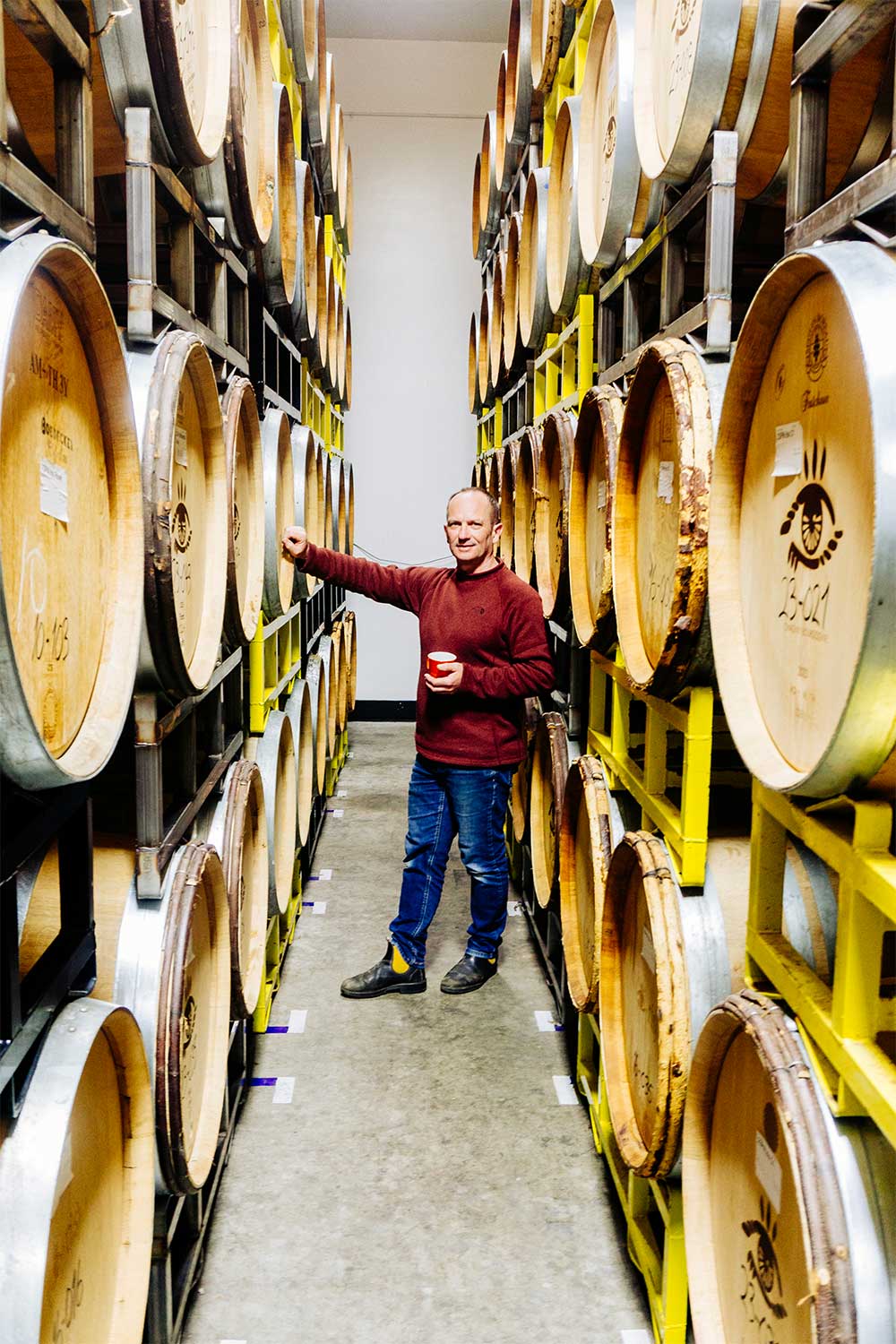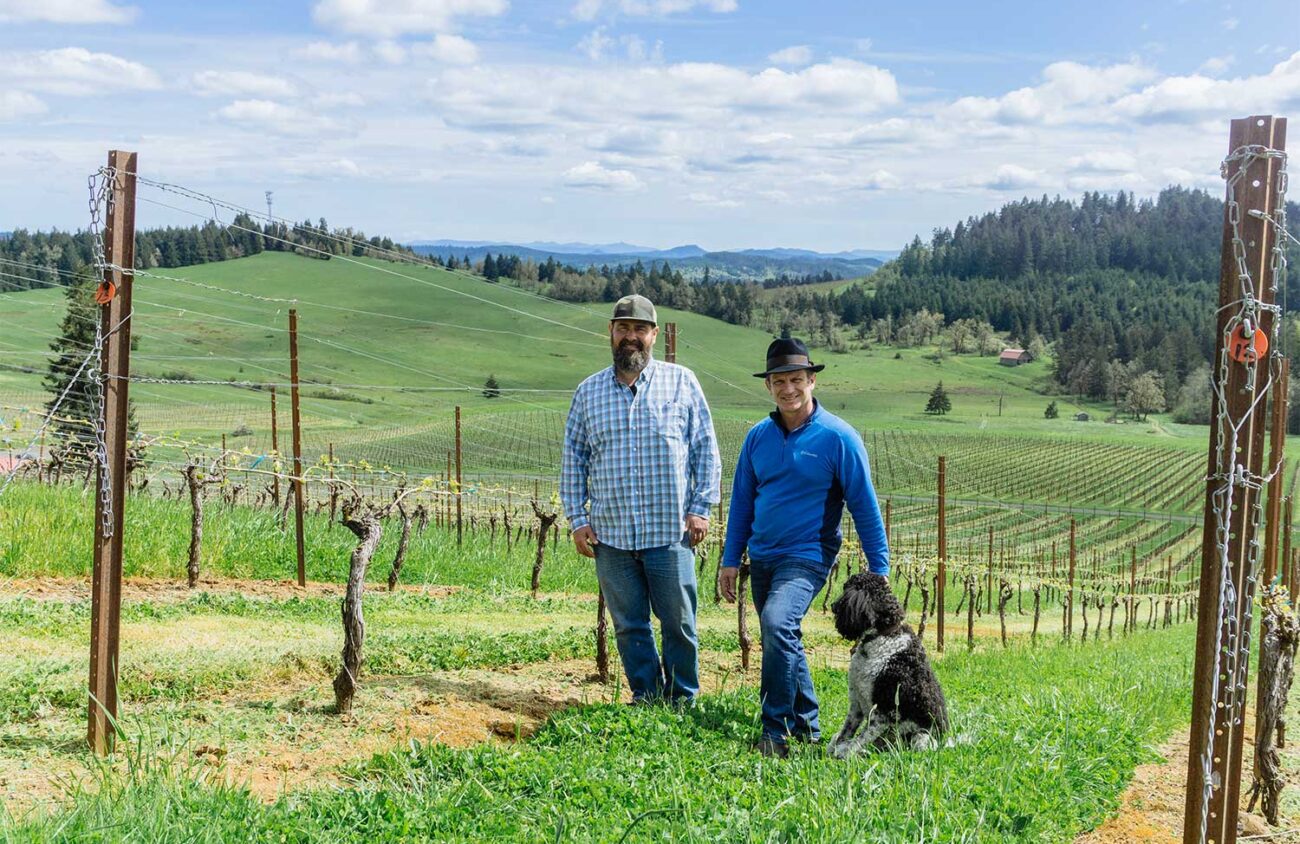Allow me to take you on a journey into wine country — Oregon wine country. Known internationally for its pinot noir, the Willamette Valley wine industry is growing every year.
Lying deep in the rolling hills of the Lorane Valley, 20 miles southwest of Eugene, is Iris Vineyards. Named after the local iris flowers that bloom in May, the vineyard manages over 36 acres of grapevines.
At that volume, the vineyard can produce over 120 tons of grapes. Per year. In my fraternity, we’d call that a shit ton of wine.
Between 850 and 1,000 feet of elevation is the perfect sweet spot for pinot noir, pinot grigio, chardonnay, riesling and pinot blanc grapes. It’s all about the climate, says Iris vineyard manager Arpad Walker. Everything from the amount of sunlight, to precipitation, to detritus on the ground — even the soil itself — affects the final taste of the wine.
“One of the many balances we seek to find in the vineyard is a balance between vegetative growth and fruitfulness,” Walker says. “And there’s different spots in the vineyard that are capable of producing more vegetation and grapes and not for some wines, like our white wines.”
Each kind of grape requires its own kind special climate, which is why pinot noir is so big here — these grapes need a cooler, more wet climate than grapes grown in California like cabernet sauvignon.
The oldest vines were planted over two decades ago. The scion of the grape variety being grown, which might be European, is joined with American rootstock to resist the soil-borne pest, phylloxera, which rots the roots and discolors the plants — killing the plants’ vigor.
“Even though we’re growing pinot noir, we’ve got a lot of different kinds of sub combinations of clone and rootstock, and those have kind of some different flavor characteristics,” Walker says.
After being dormant throughout the winter, the vines begin their vegetative growth, known as “bud break,” in mid-April, sprouting vines that reach up towards the wired trellis — helped along by Walker who brings elastic metal wire to “scoop up and catch” the emerging shoots, giving them the structure they need as they’re growing.
Spreading along the trellis for around two months, the vines begin to bloom in late June to early July — during which grape clusters begin to form, which develop and mature from July through August.
While this is happening, Walker will remove some leaves from the vine, letting more sunlight hit the “fruit zone.” This helps both control disease and develop the color and flavor compound contained within the grape skins. This is done early to get the grapes acclimated to that level of sun exposure.
“Again, there’s a balance there. If they get too much sun or too much sun late in the season when they haven’t been able to acclimatize, the grape skins can get sunburned too,” Walker says.
Late August is when the grape skins will begin to gain their final color in a phenological process called veraison. The grape berries will grow in size and begin to look like their harvest size. While this happens, the grapes will begin to fully ripen, increasing the amount of sugars developing flavors and acids to soften the berries in preparation for harvest.
The harvesting process takes around three weeks at Iris Vineyards, beginning in late September and ending in early October. All picking is done by hand with the help of seasonal workers to ensure that Iris is picking only the ripest of the ripe grapes.
“Generally, it’s about 110 days from bloom till harvest,” Walker says.
According to Walker, it’s important to pick the grape clusters early in the morning to ensure that none get spoiled while they’re transported to the Iris Winery, 13 miles north of the vineyard in Cottage Grove.
This is where the fun begins. It’s time to make some wine (in about a year and half).
After a morning of harvest and transport, the afternoon begins with the grapes being sorted, destemmed and crushed (although crushing depends on what kind of varietal the grape is). Typically, red wines are left to ferment uncrushed with the skins on — giving them their iconic color.
Then, and only then, will the best grapes be put into tanks or boxes to begin the fermentation process, says Iris Vineyards winemaker Aaron Lieberman.
During fermentation, Lieberman will add in different strains of yeast, depending on what kind of flavors and aromas he wants to emphasize in the wine. “The biggest differences being between the strains that are considered good for red wines and white wines,” Lieberman says.
The yeast will help convert the sugars from the berries into alcohol and CO2. Different strains will produce different fermentation byproducts like glycerol, esters and acetates which influence the wine’s flavor profile.
Pinot noir takes the longest to ferment since it’s stored at 12 to 15 degrees Celsius — any higher will start to kill the strain of yeast used in that varietal, according to Lieberman. However, pinot gris can ferment as quickly as seven days if temperatures rise to a range 30 to 32 degrees Celsius.
If any skins remain after fermentation is done, the juice will be pressed out, separating the skins. Then, while the wine is being “racked,” the delicious, clear wine will separate from the yeast lees, and sediment will be at the bottom of the box or tank.
However, Lieberman says they’ll occasionally do a “dirty rack” where they intentionally leave behind some lees to break down and release protein compounds back into the wine.
After racking, the wine is pumped into wood or stainless steel barrels to age for 10 months. If Lieberman wants the wine to be “over-vintage” (aged for over a year before being bottled) it will be aged in barrels for about 15 months.
“We’ll do about four months and bottle pinot gris and then pinot noir at least six,” Lieberman says. “I think a year is preferable to a bottle age for pinot noir and other reds.”

Wooden barrels are then filled and topped up periodically as they are porous, allowing water and alcohol content to evaporate over time. “As it’s sitting here aging since we lose some liquid out through the wood, the level inside the barrel starts to go down,” Lieberman says. “So each month we have to come through and fill the barrel with more wine.”
Even the kind of wood used in a barrel can end up affecting the taste and aroma of the wine.
Sparkling wine is a special case at Iris. Instead of fermenting in a box or tank, it will ferment directly in the barrel before being transferred to a bottle for a secondary fermentation process.
To get the sparkling wine’s bubbles, Iris Vineyards uses the traditional method, which involves rotating the bottles upside down every 90 minutes. An almost insurmountable task by hand, the winery has a large machine that can rotate hundreds of bottles at a time.
Aging gracefully in beautiful wooden barrels, each barrel typically holds 60 gallons of wine, which equates to 25 cases, or 300 bottles of wine.
During the bottling and labeling process, Lieberman says they’ll bring in an outside contractor who has a mobile bottling line.
From then, the wine is then distributed and transported to vendors in over 25 states across the country. Or if you’re lucky, you end up experiencing a glass of their delicious pinot noir at the Iris Vineyards wine bar in Springfield.
For Lieberman, Walker and the rest of the Iris Vineyards team, making wine isn’t just a craft — it’s an art, a science and passion all at the same time. “From a winemaking standpoint, you always want to be taking enough care with the wine from the time that they’re grapes up until you bottle them,” Lieberman says.
